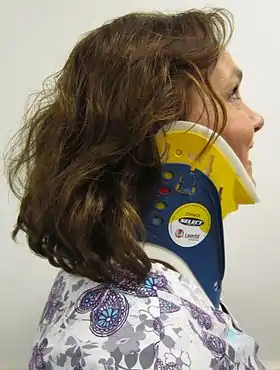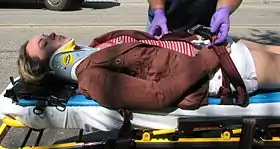Cervical collar
A cervical collar, also known as a neck brace, is a medical device used to support a person's neck. It is also applied by emergency personnel to those who have had traumatic head or neck injuries,[1] and can be used to treat chronic medical conditions.
| Cervical collar | |
|---|---|
 A side view of a person wearing a C spine collar. |
Whenever people have a traumatic head or neck injury, they may have a cervical fracture. This makes them at high risk for spinal cord injury, which could be exacerbated by movement of the person and could lead to paralysis or death. A common scenario for this injury would be a person suspected of having whiplash because of a car accident.[2] In order to prevent further injury, such people may have a collar placed by medical professionals until X-rays can be taken to determine if a cervical spine fracture exists.[3] The cervical collar only stabilizes the top seven vertebrae, C1 through C7. (Other immobilizing devices such as a Kendrick Extrication Device or a backboard can be used to stabilize the remainder of the spinal column.[1])
The routine use of a cervical collar by a first aid provider is not recommended.[4]
Cervical collars are also used therapeutically to help realign the spinal cord and relieve pain,[5] although they are usually not worn for long periods of time.[6] Another use of the cervical collar is for strains, sprains, or whiplash.[2][3] If pain is persistent, the collar might be required to remain attached to help in the healing process.[3][5] A person may also need a cervical collar, or may require a halo fixation device to support the neck during recovery after surgery such as cervical spinal fusion.[7]
Types

A soft collar is fairly flexible and is the least limiting but can carry a high risk of further breakage, especially in people with osteoporosis. It can be used for minor injuries or after healing has allowed the neck to become more stable.
A range of manufactured rigid collars are also used, usually comprising (a) a firm plastic bi-valved shell secured with Velcro straps and (b) removable padded liners. The most frequently prescribed are the Aspen, Malibu, Miami J, and Philadelphia collars. All these can be used with additional chest and head extension pieces to increase stability.
Cervical collars are incorporated into rigid braces that constrain the head and chest together.[8] Examples include the Sterno-Occipital Mandibular Immobilization Device (SOMI), Lerman Minerva and Yale types. Special cases, such as very young children or non-cooperative adults, are sometimes still immobilized in medical plaster of paris casts, such as the Minerva cast.
Use over time
As a result of several randomized clinical trials over the last decade, hospitals and ambulance staff have seen a significant reduction in the number of patients that are being immobilized.[9][10] This has been due to complications such as increased intracranial pressure with traumatic brain injury, along with access issues for airway management in obtunded patients.[11] Some medical professionals have even been calling for a ban on cervical collars, stating that they cause more harm than good.[12] There is also very little evidence that shows cervical collars to be actually making a difference in traumatic cervical spine injury.
Sport

In high-risk motorsports such as Motocross, go-kart racing and speed-boat racing, racers often wear a protective collar to avoid whiplash and other neck injuries.
Designs range from simple foam collars to complex composite devices.[13]
Additional images
 Side view of a cervical collar
Side view of a cervical collar Front view of a cervical collar. The opening provides anterior access to the neck for a cricothyrotomy or tracheotomy.
Front view of a cervical collar. The opening provides anterior access to the neck for a cricothyrotomy or tracheotomy. Side view X-ray of the neck with a cervical collar.
Side view X-ray of the neck with a cervical collar. SOMI brace.
SOMI brace. Cervical collar.
Cervical collar. Neck collar attachment during a military simulation, replacing manual stabilization of the head.
Neck collar attachment during a military simulation, replacing manual stabilization of the head.
See also
References
- Mistovich, Joseph J.; Brent Q. Hafen; Keith J. Karren (2000). Brady Prehospital Emergency Care (6 ed.). Upper Saddle River, NJ: Prentice-Hall. pp. 662. ISBN 978-0-8359-6064-9.
- "Whiplash". WebMD. Retrieved 2008-03-07.
- "Neck Strains". WebMD. Retrieved 2008-03-07.
- "European Resuscitation Council Guidelines for Resuscitation 2015 Section 9. First aid | ERC Guidelines for resuscitation 2015". ercguidelines.elsevierresource.com. Retrieved 12 March 2018.
- "Cervical Disc Disease Treatment: Physical Therapy and Other Options". WebMD. Retrieved 2008-03-07.
- "Office Ergonomics - Other Treatment for Injuries Related to the Workstation". WebMD. Archived from the original on 2008-03-28. Retrieved 2008-03-07.
- "Cervical spinal fusion". WebMD. Archived from the original on 2008-03-30. Retrieved 2008-03-07.
- Shantanu S Kulkarni, DO and Robert H Meier III, "Spinal Orthotics", Medscape Reference.
- Rogers, Leigh (2017). "No place for the rigid cervical collar in pre-hospital care". International Paramedic Practice. 7 (1): 12–15. doi:10.12968/ippr.2017.7.1.12. ISSN 2052-4889.
- Sundstrøm, Terje; Asbjørnsen, Helge; Habiba, Samer; Sunde, Geir Arne; Wester, Knut (2014-03-15). "Prehospital Use of Cervical Collars in Trauma Patients: A Critical Review". Journal of Neurotrauma. 31 (6): 531–540. doi:10.1089/neu.2013.3094. ISSN 0897-7151. PMC 3949434. PMID 23962031.
- Patel, Mayur B.; Humble, Stephen S.; Cullinane, Daniel C.; Day, Matthew A.; Jawa, Randeep S.; Devin, Clinton J.; Delozier, Margaret S.; Smith, Lou M.; Smith, Miya A. (February 2015). "Cervical spine collar clearance in the obtunded adult blunt trauma patient". Journal of Trauma and Acute Care Surgery. 78 (2): 430–441. doi:10.1097/ta.0000000000000503. ISSN 2163-0755. PMC 4409130. PMID 25757133.
- Plumb, James O.M.; Morris, Craig G. (January 2013). "Cervical Collars: Probably Useless; Definitely Cause Harm!". The Journal of Emergency Medicine. 44 (1): e143. doi:10.1016/j.jemermed.2012.05.031. ISSN 0736-4679. PMID 22883718.
- "Valhalla Adult 360 Plus Device Karting Neck Brace". Retrieved 2010-08-16.